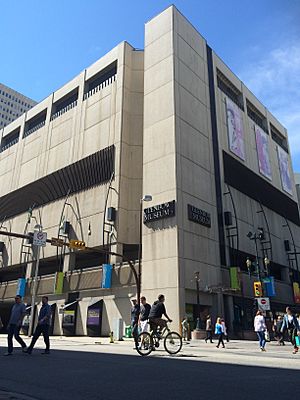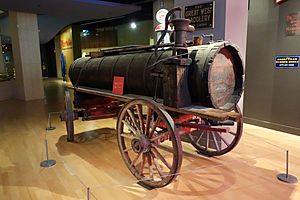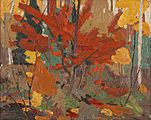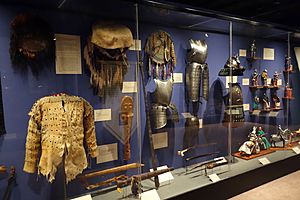Glenbow Museum facts for kids
 |
|
| Established | 1966 |
|---|---|
| Location | Calgary, Alberta, Canada |
| Type | Anthropology, art, history, mineralogy |
| Visitors | 148,668 (2019) |
| Founder | Eric Lafferty Harvie |
| Public transit access | City Hall C-Train station |
The Glenbow Museum is a cool place in Calgary, Alberta, Canada. It's a museum that shows off art and history, especially about Western Canadian life. This includes amazing stories and items from Indigenous peoples. The Glenbow Museum first opened its doors in 1966.
The museum moved to its current spot in downtown Calgary in 1976. It gets money from the governments of Calgary, Alberta, and Canada. Private donors also help out. In 2019, almost 150,000 people visited the museum. The Glenbow Museum closed for big updates in 2021. It is set to open again in 2026.
Good news! Since February 2022, it's free to get into the museum. This is thanks to a huge donation of $25 million from the Shaw Family Foundation. Part of this money helps keep admission free forever. The rest helps create a new art institute.
Contents
History of the Glenbow Museum
How it Started
The Glenbow Museum began with a man named Eric Lafferty Harvie. He was a lawyer and businessman from Alberta. In the 1940s, he became very rich from the oil industry.
Harvie loved collecting things. He wanted to help people understand the history of Western Canada better. So, in 1955, he started the Glenbow Foundation. It was named after his ranch. The goal was to collect and save art, old papers, and artifacts. At first, the foundation just collected items. Other museums would then show them.
Harvie collected many items from Western Canadian culture. These things were not popular at the time. This meant the collection grew very quickly. People often donated things they thought were "junk." Harvie was especially interested in items from Indigenous peoples of North America. He also collected things from all over the world.
Becoming a Public Museum
In 1964, the Glenbow Foundation teamed up with the Alberta government. They opened a museum in an old courthouse in Calgary. But the building was too small for all the amazing collections.
A big change happened in 1966. Eric Harvie, who was having health problems, gave his entire collection to the people of Alberta. This was a special gift for Canada's 100th birthday. The government then created the Glenbow–Alberta Institute. This new institute was run by a group of volunteers. It was funded by Harvie and the Alberta government. In 1973, the institute also became responsible for keeping Calgary's old city records.
The Glenbow needed a bigger home for its growing collection. So, in 1973, plans were made for a new building. The Alberta government paid for most of it. The new eight-story building opened to the public on September 22, 1976. It was built right across from the Calgary Tower.
In the 1980s, the museum faced money problems. But people in Alberta donated money to help keep it open.
Recent Updates
The Glenbow Museum is currently led by Nicholas R. Bell. In 2021, the museum received $94 million from the Canadian, Alberta, and Calgary governments. This money is for a big redesign and renovation of the downtown building. The museum also plans to raise more money from private donors.
The museum closed on August 29, 2021, for these renovations. It will reopen in 2026. While the main building is closed, the museum still shows exhibits at other locations. As mentioned, admission to the museum became free in February 2022. This was made possible by a $25 million donation from the Shaw Family Foundation. Part of this money helps fund the new JR Shaw Institute for Canadian Art.
Museum Collections
The Glenbow Museum has many different collections. They include artifacts from Western Canada and other cultures worldwide. The museum also has a collection of cool gems and minerals.
Archives
The Glenbow archives are one of the biggest collections of old records in Canada. They are a major place for people to do research. This includes historians, writers, students, and people looking into their family history. The archives have tons of old papers, over a million photos, and many hours of film and sound recordings.
These records cover the social, political, and economic history of Western Canada. They focus especially on Calgary and southern Alberta. You can find information on First Nations, Métis family trees, the Royal Canadian Mounted Police, and ranching. There are also old maps, school yearbooks, and records of land sales.
Art Collection
The Glenbow's art collection has about 33,000 artworks. Most of these are from the 1800s to today. They mainly show historical, modern, and current art from or about northwestern North America. The collection includes beautiful landscape paintings. It also has Canadian prints and art by First Nations and Inuit artists. Art from other parts of the world helps show a wider view.
- Selected works
-
Emily Carr, Kitwancool, 1928
Library
The Glenbow's library has 100,000 books, magazines, newspapers, and maps. All of these are about Western Canada. They cover everything from when buffalo roamed the plains to the arrival of the railroad. You can also find information on current events in Alberta. The collection includes rare old books about horses. There are also school books from one-room schoolhouses.
Community History

The Community History collection shows how people lived in southern Alberta from 1880 to 1970. It has many items like old pottery and textiles. It also includes items from Doukhobor and Hutterite communities in Western Canada. You can even see artifacts from the Calgary Stampede.
This collection has over 100,000 objects from all over the world. They help us understand life in Western Canada from the late 1800s until today. Some items are shown in the Mavericks: An Incorrigible History of Alberta exhibit. This exhibit tells Alberta's history through the stories of 48 special people.
Military and Mounted Police
The Military and Mounted Police collection has many items about Canadian military history. It focuses on southern Alberta. The museum also has European and Japanese armor, weapons, and firearms from around the world.
The armor part of the collection has many European and Japanese pieces. In fact, the museum's collection of Japanese armor is the largest in Canada. The "Canada at War" section focuses on Canada's role in the North-West Rebellion, World War I, World War II, and the Korean War. The "Mounted Police" section shows items about the North-West Mounted Police and the Royal Canadian Mounted Police.
The Glenbow's military collection is the most varied in Western Canada. It has 26,000 items, including 2,100 firearms. Many items from this collection are in the Warriors: A Global Journey Through Five Centuries exhibit. This exhibit compares how different cultures approached war throughout history.
Minerals
The museum's Minerals collection includes minerals and precious stones from around the world. It especially features those from Western Canada. You can see minerals that glow in the dark. There's also a display of fool's gold. You can even see a piece of the Earth's oldest rock! The exhibit also has rock crystals in every color.
Many items from the Mineral collection are in the Treasures of the Mineral World exhibit. This is a permanent exhibit at the Glenbow Museum.
Native North America

The Native North America collection is a large group of artifacts. They come from various indigenous peoples of North America, especially the Plains Indians. The museum organizes this collection into sections like Inuit, Métis, Northwest Coast, and Plains.
The Plains section focuses on Indigenous peoples of the northwestern Plains. This includes the Anishinaabe, the Niitsitapi, Cree, and Tsuut'ina Nation. The Northwest Coast section focuses on the Indigenous peoples of the Pacific Northwest Coast. This includes the Kwakwaka'wakw and the Nuu-chah-nulth.
The Glenbow's ethnology collection has about 48,000 items. Niitsitapiisinni: Our Way of Life is a permanent exhibit. It focuses on the Niitsitapi and features many items from this collection.
World Cultures
The Glenbow Museum also has many artifacts from around the world. Its collection is divided into Africa, Asia, Latin America, and Oceania. The museum's African collection has over 5,000 items. Most of these were collected in the 1960s. It focuses on West Africa.
The museum's Latin American collection also started in the 1960s. It mainly focuses on the Amazon Basin. The Oceania collection mostly has artifacts from Papua New Guinea.
"Many Faces, Many Paths: Art of Asia" shows more than 80 statues and sculptures. These are Buddhist and Hindu items, some dating back to the first century. Most of these were donated by a private oil and gas company from Calgary. The Asian collection includes Buddhist and Hindu art from many countries.
Where Symbols Meet: A Celebration of West African Achievement is a permanent exhibit at Glenbow. It features many items from the museum's West African collection.
See also
- List of art museums
- List of museums in Alberta





